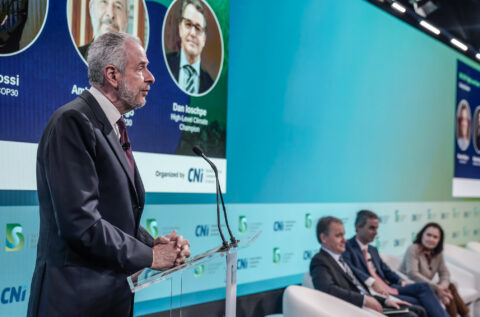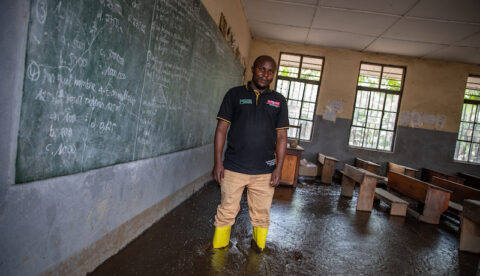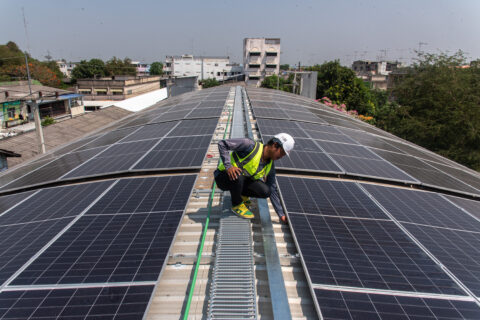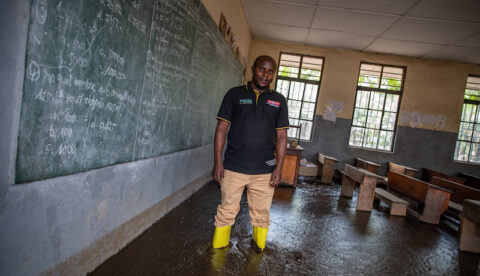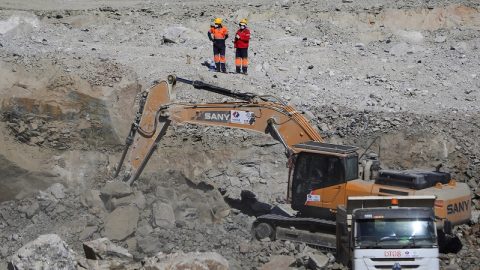Welcome to Carbon Brief’s China Briefing.
Carbon Brief handpicks and explains the most important climate and energy stories from China over the past fortnight. Subscribe for free here.
Key developments
Clean-energy industry drives China growth in 2023
CLEANTECH BOOM: New analysis for Carbon Brief found that clean-energy sectors – spanning low-carbon power, grids, energy storage, electric vehicles (EVs) and railways – contributed 11.4tn yuan ($1.6tn) to China’s economy in 2023, accounting for “all of the growth in Chinese investment and a larger share of economic growth than any other part of the economy”. This was driven, in particular, by the “new three” industries of solar power, EVs and batteries. Investment totalled 6.3tn yuan ($890bn), growing 40% year-on-year and almost equalling all global investments in fossil fuel supply last year – or the entire economies of Switzerland or Turkey.
GDP BOOST: Clean-energy sectors accounted for 40% of the expansion of GDP in 2023, the analysis showed. Without this contribution, China’s GDP would have risen only by 3% instead of 5.2% – well below the growth target set for 2023. This makes the industry not only crucial for China’s energy transition, but also for “broader economic and industrial” development, found the analysis.
OVERCAPACITY CONCERNS: However, the analysis continued, “the spectre of overcapacity means China’s clean-energy investment growth…cannot continue indefinitely”, adding that “the manufacturing expansion has already saturated most of the global market”. In related news, Jiemian reported exports of the “new three” industries reached more than 1tn yuan ($141bn). This has seen the EU, among others, take steps to support their own clean-energy industries, reported Agence France-Presse, adding that Chinese premier Li Qiang recently held “frank” talks with European Commission president Ursula von der Leyen on trade imbalances.
China relaunched voluntary carbon market
RESUMED TRADING: State-run broadcaster CCTV reported that China’s voluntary carbon-trading system, the China Certified Emission Reduction (CCER) programme, resumed trading on 22 January. CCER’s relaunch “marks the completion of China’s domestic carbon-market architecture”, the broadcaster added. Beijing News described CCER as an “institutional innovation to mobilise the power of the whole society to participate in greenhouse gas emission reduction actions”.
NEW CREDITS?: Economic outlet Jiemian said that CCER project registration was suspended in 2017. It reported that “preparation on the policy end” for restarting issuance of carbon credits under the scheme is “almost complete”, pending the “state administration for market regulation (SAMR)…releas[ing] the list of recognised validation and verification institutions”. The scale of new CCER issuance is predicted to be between tens of millions to 100m tonnes per year, according to one analyst, the newspaper adds.
INCLUDED SCOPE: Finance news outlet EastMoney reported that the greenhouse gas trading under the scheme is primarily open to enterprises or institutions in four major sectors: “afforestation carbon sinks, grid-connected solar-thermal power generation, grid-connected offshore wind power generation and mangrove plantation”. It may in future allow individuals “to sell carbon emissions generated from green behaviours under the CCER scheme…as the trading mechanism matures”, according to the South China Morning Post.
Tasks, measures and timelines for ‘Beautiful China’
BEAUTIFUL CHINA: The top bodies of the Chinese government and governing Communist party – the state council and the central committee, respectively – issued the full text of new instructions on “comprehensively promoting the construction of a Beautiful China” in a 27 December official release, published by state news agency Xinhua on 11 January. The Beautiful China initiative is a “top-level development blueprint detailing specific targets for…the nation’s green and high-quality growth”, another Xinhua report explained. ClientEarth’s Dimitri De Boer wrote in China Dialogue that the initiative “ties a good environment to a sense of national pride”.
KEY GOALS: The document outlined a slew of tasks, measures and timelines within China’s overall push to peak its carbon emissions before 2030 and reach carbon neutrality by 2060. By 2027, “green and low-carbon development” will be “further promoted”, it said. By 2035, “green production methods and lifestyles will be widely formed”. By the middle of the century, “ecological civilisation will be comprehensively upgraded…[with] deep decarbonisation achieved in key areas”. Goals listed in the document include: the country will compile an annual national greenhouse gas inventory; “gradually shift” to “dual control” of carbon emissions; protect more than 3.15m square kilometres of land from being eligible for development projects under the national ecological “red line” policy; ensure China’s cities become “waste-free” by 2035; and see new energy vehicles (NEVs, mostly electric vehicles) comprise around 45% of new cars by 2027.
OFFICIAL COMMENT: The document was passed in a meeting chaired by Chinese president Xi Jinping, who said that “building a Beautiful China is an important goal for building a modern socialist country”, the state-run China Daily reported – giving the document more weight and signalling to officials that China’s carbon-neutrality goals remain an important target. Adding to the momentum, following its publication, Sun Jinlong and Huang Runqiu – the Communist party secretary and the minister at the ministry of ecology and environment (MEE), respectively – wrote an opinion piece in the Communist party-backed newspaper People’s Daily saying that the document “clearly defines the overall requirements, key tasks and major initiatives” guiding the Beautiful China initiative. In an interview with Xinhua, a senior official of the MEE said incentives and policy measures could “mobilise enthusiasm, initiative and creativity” to build a Beautiful China.
US and China climate envoys step down
KERRY RETIRES: US climate envoy John Kerry plans to retire from his role in the next few months, in order “to help President Biden’s [re-election] campaign”, Axios reported. In stepping back from “a major diplomatic role that was created especially for him”, the New York Times reported, Kerry casts the position into “an uncertain future”. The fact that he has chosen to do so following the retirement of Chinese climate envoy Xie Zhenhua “[raises] concerns about what climate diplomacy will look [like]” without their cooperative personal dynamic, it added.
END OF AN ERA: Xie and Kerry “have a close personal relationship”, Climate Home News reported, adding that “Xie’s return from retirement in 2021 was widely interpreted as a response to Kerry’s appointment [to the climate envoy role]”. “If Kerry and Xie weren’t in office…there’s no way we’d be even close to where we’re at,” the Financial Times quoted Jake Schmidt, a senior director at thinktank NRDC, saying. It also reported that Kerry said he and Xie were “doing all we can to stay in very close touch; and he and I will continue to work in respective institutions [to forge collaboration on climate change]”.
NEW BLOOD: Career diplomat Liu Zhenmin – profiled in Carbon Brief’s DeBriefed newsletter – will become China’s new climate envoy, Reuters reported. The newswire added that Liu has “long experience in climate diplomacy”, participating in both the Kyoto Protocol and Paris Agreement negotiations. Liu “was a key driver in landing the Kyoto Protocol”, Greenpeace East Asia chief China representative Yuan Ying told Carbon Brief, which is “a promising piece of experience”. However, Climate Home News quoted an anonymous analyst as saying “many experts wanted someone from the environment ministry appointed”, as “[the foreign ministry] approaches climate as a card in US-China [manoeuvring]” instead of seeing it “as a real issue that needs to be solved”.
Spotlight
Interview with Prof Zou Ji, CEO and president of the Energy Foundation China

At COP28, Carbon Brief sat down with Prof Zou Ji, CEO and president of the Energy Foundation China, to discuss China’s energy transition.
Prof Zou previously served as a deputy director-general of China’s National Center for Climate Change Strategy and International Cooperation.
He was part of China’s negotiation team for the Paris Agreement and a lead author of several Intergovernmental Panel on Climate Change assessment reports.
Below are highlights from the wide-ranging conversation, covering China’s stance on coal, renewables, issues-based alliances and more. The full interview will be published on the Carbon Brief website soon.
China’s decisions at COP28
On signing pledges at COP: “If you look at the whole history of the COP…I do not [remember] China joining any alliances. I have never seen that…As a party, China [is only concerned with] official procedures, waiting for a legal framework of the UNFCCC or the Paris Agreement.”
On why China did not join the pledge to triple renewables and double efficiency: “[Before COP28] we have not seen [it laid out] very clearly which year should be the base year [from which tripling renewables should be calculated]. Should it be 2020? Should it be 2022? This might seem to be technical but, [in] the past two years, global development of renewables, especially in China, [have been significantly boosted, and so]…the difference in targets might be very significant.”
On China’s commitment to decarbonisation: “If you look back at history, there have been very few cases that show China [first making] and then [giving up] a commitment. This is not the political culture in China.”
The future of coal
On fossil fuel phaseout: “I would like to see…[China] very quickly enlarging its renewable capacity. Only if [there is] adequate capacity and generation of renewables can this lead to a real phasing out or phasing down of fossil fuels.”
On others’ views of required coal capacity: “Even though China will reach its [2060] carbon neutrality target, it will continue to have to maintain 600 gigawatts of coal-fired power plant capacity. These are the sort of estimations [we’re working with now].” (Prof Zou disagrees with this, believing that renewables growth, better grid connectivity and increased energy storage capacity should reduce the need for such a large amount of coal capacity.)
On the need for CCUS: “In some sectors, like, for example, iron and steel, cement, chemicals and petrochemicals, we do need carbon capture, utilisation and storage (CCUS), because it is very difficult to phase out coal or carbon dioxide [completely].”
On CCUS in the power sector: “I have mixed feelings about CCUS for the power sector. I have an ideal vision that we can reach real zero emissions in these sectors through a more developed grid system, with more connectivity across provinces or regions and the use of AI technology.”
Transitioning to renewable energy
On ensuring more renewables uptake: “We have raised the share of renewable power generation from seven, eight, nine per cent to today’s 16%. This is progress, but it is not quick enough or large enough. We want to push the grid companies…to do more and do it faster.”
On the power of distributed solar: “We should also consider…creat[ing] another, totally new power system. This would be a sort of nexus of a centralised and decentralised grid system…If [the central grid] is having difficulties [increasing renewable generation], and if these are very challenging to overcome, then let’s [shift] to a lot of microgrids.”
On distributed solar growth: “Today, the share of distributed [renewables] is still lower than centralised renewables. But the incremental [distributed] renewables growth has become higher than growth of centralised renewables in the past year or two, and I would assume this will remain a trend in the future.”
Measuring energy use
On China’s electricity consumption: “For low-income level groups, although their income has not grown very much, their consumption preferences and mindsets – especially for younger generations of consumers – mean they are more willing to use electricity [than previous generations].”
On comparisons of China to the EU and US: “There is a structural [difference] compared to the [energy mix] in Europe and the US. The majority of energy use [in China] has been for industrial production, rather than for residential [use]…In China, the average power consumption per capita is around 6,000 kilowatt-hours (kWh), compared to 8,000kWh in Europe and over 12,000kWh in the US.”
On energy efficiency: “Physically, I think China has become better and better [in terms of] its efficiency, but, economically, this cannot produce as high a value-add as Europe and the US in monetary terms.”
On challenges calculating carbon intensity: “The raising of interest rates by the US Federal Reserve makes US dollars more expensive, increasing foreign exchange rates which then enlarges the monetary GDP gap making Chinese GDP [in dollar terms] fall, and carbon intensity rise.”
Watch, read, listen
FOSSIL FUEL HIGHS: Clyde Russell, Asia commodities and energy columnist at Reuters, wrote that, although China’s crude oil and coal imports “all soared to record highs in 2023”, crude oil is likely being added to inventories rather than being used, while the spike in coal is a temporary response to hydropower shortages.
ROSEWOOD DEFORESTATION: The China-Global South Project spoke to Ma Haibing, Asia policy specialist at the Environmental Investigation Agency, about illegal harvesting of rosewood by Chinese traders in the “rapidly shrinking forests” of west Africa.
GREEN SHOOTS: Yicai interviewed Zhang Xiaoqiang, executive vice-president of the China Center for International Economic Exchanges (CCIEE), on prospects for “green” development in China in 2024, the growth of renewables, cross-provincial power transmission and other topics.
ANTARCTIC RESEARCH: CCTV broadcasted a short news report on the progress of the 40th Chinese Antarctic research expedition in building China’s newest research station in Antarctica.
New science
Drought-related wildfire accounts for one-third of the forest wildfires in subtropical China
Agricultural and Forest Meteorology
A new study found that “drought plays a dominant role” in wildfires in subtropical China, adding that “from 2001 to 2020, excess wildfires caused by drought accounted for approximately 31% of the total number of forest fire points during the fire season (November to May)”. As the drying trend caused by climate change intensifies, wildfires will “show different patterns due to the large differences in the sensitivity of wildfire to drought in subtropical China”, it added.
Bulletin of the American Meteorological Society
Human-caused climate change made the August 2022 heatwave in southern China 50% hotter than it would have been without global warming, according to new research. The heatwave, the researchers noted, was “extraordinary and unprecedented”, being the “longest-lasting and most intense [China has seen] since 1961”. The study also found that, although it was focused on southern China, “the main conclusions also apply to the eastern Tibetan plateau”.
Potential for CO2 storage in shale basins in China
International Journal of Greenhouse Gas Control
Researchers used the latest data to calculate new “potentials of [carbon dioxide (CO2)] storage in major shale gas/oil basins in China”, driven by the fact that China, as the second largest shale gas and oil producing country, possesses “large and significant” shale basins. They found that China could sequester approximately 6,194bn tonnes of CO2 in shale basins, equivalent to 620 years’ of China’s projected carbon emissions.
China Briefing is compiled by Anika Patel and edited by Wanyuan Song and Simon Evans. Please send tips and feedback to china@carbonbrief.org
The post China Briefing 25 January: Clean energy drives growth; ‘Beautiful China’ instructions; Interview with EFC’s Prof Zou Ji appeared first on Carbon Brief.
Climate Change
Foreign aid cuts put adaptation finance pledge at risk, NGOs warn
Ongoing cuts by rich nations to foreign aid are threatening their pledge to double finance by the end of this year to help developing countries adapt to climate change, a new report has warned.
Adaptation finance provided by developed countries is expected to decrease as a result of reductions in overseas development spending and may only reach $26 billion in 2025, according to projections by NGOs Oxfam and the CARE Climate Justice Centre.
That would be far short of the estimated $40 billion needed to honour the promise developed countries made four years ago at COP26 in Glasgow to double their adaptation finance from 2019 levels.
Even if achieved, the goal represents a small fraction of the estimated $215 billion-$387 billion a year that developing nations need to become more resilient in a warming world.
International adaptation funding needs to grow sixfold to $12 billion a year for small island developing states (SIDS), which face an existential threat from rising seas, according to a separate report by the Global Center on Adaptation (GCA) out this week.
Foreign aid slashed
Resilience-boosting interventions in poorer countries have historically relied to a large extent on foreign aid, which is now shrinking as wealthy donors redirect cash to other areas, such as defence. Most notably, the Trump administration has dismantled the US Agency for International Development (USAID) – but other wealthy donors, including Germany and France, have also slashed aid spending in 2025.
Overall, overseas development aid (ODA) is expected to decline by between 9% and 17% in 2025, on top of a 9% drop in 2024, according to the Organisation for Economic Co-operation and Development (OECD).
John Norbo, a senior climate advisor at CARE Denmark, said aid cuts in wealthy countries leave “the poorest to pay the price, sometimes with their lives”.
“Rich countries are failing on climate finance and they have nothing like a plan to live up to their commitments to increase support,” he added. “COP30 must deliver justice, not another round of empty promises.”
Brazil’s COP30 presidency has promised that adaptation will be a “central theme” of the summit.
Governments are expected to agree on a list of around 100 indicators to track resilience to climate change as part of the Global Goal on Adaptation, while also being encouraged – along with the private sector – to help fund measures in National Adaptation Plans – whether rural water management, resilient health systems, or city heat assessments.
“We are expecting – and stand ready – to support all countries that are willing to use COP30 as a platform to show their leadership on adaptation finance, on adaptation planning, on adaptation delivery,” Alice de Moraes Amorim Vogas, programme director for the COP30 presidency, told a recent event at Climate Week in New York.
But it is still unclear whether governments will agree at COP30 on any new dedicated financial target to replace the expiring one. The world’s poorest nations – represented in the climate negotiations by the Least Developed Countries (LDCs) group – are calling for a fresh commitment to triple adaptation finance by 2030 on 2022 levels.
Loans for adaptation add to debt burdens
The research by Oxfam and CARE also found that a significant share of climate finance – including for adaptation – is still provided as loans that, the campaigning groups say, burden developing countries with debt for a crisis that they did not cause.
For the 2021-2022 period, loans made up on average 41% of adaptation finance provided directly by wealthy governments and around three-quarters of adaptation funding disbursed by multilateral institutions such as development banks, the report found.
The NGOs estimated that developing countries will have to pay back between 30% and 50% more of the money they were lent in 2022 for adaptation programmes as a result of interest repayments.
For Oxfam’s climate policy lead Nafkote Dabi, this represents a form of “crisis profiteering”. “Rich countries are treating the climate crisis as a business opportunity, not a moral obligation,” she said.
‘Running out of time’
France, Japan, Italy and Spain provided most of their climate finance over the 2021-2022 period as loans or other non-grant instruments such as equity. On the other hand, grants made up all, or nearly all, of climate finance contributions made by Denmark, the Netherlands, Switzerland and Australia, the report found.
For small island states, which also receive nearly half of their adaptation money as loans, a relatively modest uptick in funding support can go a long way in shielding them from escalating climate impacts, the GCA report found. The estimated $12 billion in annual climate finance needed is a large sum for SIDS, but represents only 1.2% of all global climate finance flows, it added.
“We face rising seas, threats to food and water security, and we are running out of time,” Hilda Heine, president of the Marshall Islands, said in a statement. “Adaptation remains our most urgent priority. It is our first line of defence.”
The post Foreign aid cuts put adaptation finance pledge at risk, NGOs warn appeared first on Climate Home News.
Foreign aid cuts put adaptation finance pledge at risk, NGOs warn
Climate Change
Colombia proposes expert group to advance talks on minerals agreement
Colombia wants countries to discuss options for a global agreement to ensure that the extraction, processing and recycling of minerals – including those needed for the clean energy transition – don’t harm the environment and human wellbeing.
The mineral-rich nation is proposing to create an expert group to “identify options for international instruments, including global and legally-binding instruments, for coordinated global action on the environmentally sound management of minerals and metals through [their] full lifecyle”.
Colombia hopes this will eventually lead to an agreement on the need for an international treaty to define mandatory rules and standards that would make mineral value chains more transparent and accountable.
The proposal was set out in a draft resolution submitted to the UN Environment Assembly (UNEA) earlier this week and seen by Climate Home News. UNEA, which is constituted of all UN member states, is the world’s top decision-making body for matters relating to the environment. The assembly’s seventh session will meet in Kenya in December to vote on countries’ proposals.
Soaring demand for the minerals used to manufacture clean energy technologies and electric vehicles, as well as in the digital, construction and defence industries have led to growing environmental destruction, human rights violations and social conflict.
Colombia argues there is an “urgent need” to strengthen global cooperation and governance to reduce the risks to people and the planet.
Options for a global minerals agreement
The proposal is among a flurry of initiatives to strength global mineral governance at a time when booming demand is putting pressure on new mining projects.
Colombia, which produces emeralds, gold, platinum and silver for exports, first proposed the idea for a binding international agreement on minerals traceability and accountability on the sidelines of the UN biodiversity talks it hosted in October 2024.
Since then, the South American nation has been quietly trying to drum up support for the idea, especially among African and European nations.
Its draft resolution to UNEA7 contains very few details, leaving it open for countries to discuss what kind of global instrument would be best suited to make mineral supply chains more transparent and sustainable.
Does the world need a global treaty on energy transition minerals?
Colombia says it wants the expert group to build on other UN initiatives, including a UN Panel on Critical Energy Transition Minerals, which set out seven principles to ensure the mining, processing and recycling of energy transition minerals are done responsibly and benefit everyone.
The group would include technical experts and representatives from international and regional conventions, major country groupings as well as relevant stakeholders.
It would examine the feasibility and effectiveness of different options for a global agreement, consider their costs and identify measures to support countries to implement what is agreed.
The resolution also calls for one or two meetings for member states to discuss the idea before the UNEA8 session planned in late 2027, when countries would decide on a way forward.
No time to lose for treaty negotiations
Colombia’s efforts to advance global talks on mineral supply chains have been welcomed by resource experts and campaigners. But not everyone agrees on the best strategy to move the discussion forward at a time when multilateralism is coming under attack.
Johanna Sydow, a resource policy expert who heads the international environmental policy division of the Heinrich-Böll Foundation, said she had hoped that the resolution would explicitly call for negotiations to begin on an international minerals treaty.
“Treaty negotiations take a long time. If you don’t even start with it now, it will take even longer. I don’t see how in two or three years it will be easier to come to an agreement,” she told Climate Home.
Despite the geopolitical challenges, “we need joint rules to prevent a huge race to the bottom for [mineral] standards”. That could start with a group of countries coming together and starting to enforce joint standards for mining, processing and recycling minerals, she said.
But any meaningful global agreement on mineral supply chains would require backing from China, the world’s largest processor of minerals, which dominates most of the supply chains. And with Colombia heading for an election in May, it will need all the support it can get to move its proposal forward.
‘Voluntary initiative won’t cut it’
Juliana Peña Niño, Colombia country manager at the Natural Resource Governance Institute, is more optimistic. “Colombia’s leadership towards fairer mineral value chains is a welcome step,” she told Climate Home News.
“At UNEA7, we need an ambitious debate that gives the proposed expert group a clear mandate to advance concrete next steps — not delay decisions — and that puts the voices of those most affected at the centre. One thing is clear: the path forward must ultimately deliver a binding instrument, as yet another voluntary initiative simply won’t cut it,” she said.
More than 50 civil society groups spanning Latin America, Africa and Europe previously described Colombia’s work on the issue as “a chance to build a new global paradigm rooted in environmental integrity, human rights, Indigenous Peoples’ rights, justice and equity”.
“As the energy transition and digitalisation drive demand for minerals, we cannot afford to repeat old extractive models built on asymmetry – we must redefine them,” they wrote in a statement.
Main image: The UN Environment Assembly is hosted in Nairobi, Kenya. (Natalia Mroz/ UN Environment)
The post Colombia proposes expert group to advance talks on minerals agreement appeared first on Climate Home News.
Colombia proposes expert group to advance talks on minerals agreement
Climate Change
California Sanctions Stark Disparities in Pesticide Exposure During Pregnancy
If you’re young, pregnant and Latina, chances are you live near agricultural fields sprayed with higher levels of brain-damaging organophosphate pesticides.
A baby in the womb has few defenses against industrial petrochemicals designed to kill.
California Sanctions Stark Disparities in Pesticide Exposure During Pregnancy
-
Climate Change2 years ago
Spanish-language misinformation on renewable energy spreads online, report shows
-
Climate Change Videos2 years ago
The toxic gas flares fuelling Nigeria’s climate change – BBC News
-
Climate Change2 months ago
Guest post: Why China is still building new coal – and when it might stop
-

 Greenhouse Gases1 year ago
Greenhouse Gases1 year ago嘉宾来稿:满足中国增长的用电需求 光伏加储能“比新建煤电更实惠”
-

 Climate Change1 year ago
Climate Change1 year ago嘉宾来稿:满足中国增长的用电需求 光伏加储能“比新建煤电更实惠”
-
Greenhouse Gases2 months ago
Guest post: Why China is still building new coal – and when it might stop
-

 Carbon Footprint1 year ago
Carbon Footprint1 year agoUS SEC’s Climate Disclosure Rules Spur Renewed Interest in Carbon Credits
-
Renewable Energy3 months ago
US Grid Strain, Possible Allete Sale

